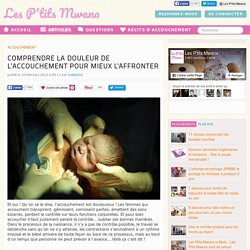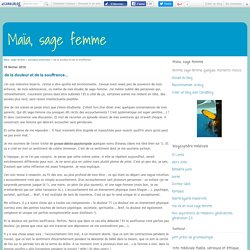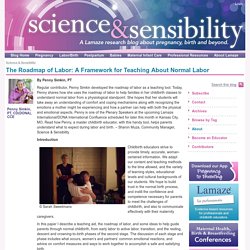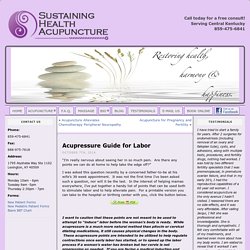

Les stades du travail et de l'accouchement. L’accouchement normal se produit au terme de la grossesse, soit entre la 37e et la 42e semaine de grossesse.

Vous trouverez ci-dessous la description des différents stades de l’accouchement. Nous vous invitons aussi à lire notre fiche sur le rôle de la future mère et du futur père au cours du travail et de l’accouchement. Vous y trouverez des conseils qui vous aideront à bien vivre cette expérience. Stade 1 : Le travail Le premier stade commence lorsque des contractions régulières se font sentir. Les différents stades du travail peuvent être vécus différemment par chaque femme.
La durée de ce stade varie selon différents facteurs. La durée moyenne du premier stade pour un premier accouchement est de 12,5 heures, mais peut varier de 7 à 16 heures. Ne touchez pas à ma douleur. La douleur pendant l'accouchement. 1/ La DISCUSSION PARENTS/PROFESSIONNELS du 26/09/2011 2/ OUTILS PRATIQUES 3/ Témoingage.

Comprendre la douleur de l’accouchement pour mieux l'affronter. Et oui !

Qu’on se le dise, l’accouchement est douloureux ! Les femmes qui accouchent transpirent, gémissent, vomissent parfois, émettent des sons bizarres, perdent le contrôle sur leurs fonctions corporelles. Et pour bien accoucher il faut justement perdre le contrôle… oublier ses bonnes manières. Dans le processus de la naissance, il n’y a pas de contrôle possible, le travail se déclenche sans qu’on ne s’y attende, les contractions s’enchaînent à un rythme imposé et le bébé arrivera de toute façon au bout de ce processus, mais au bout d’un temps que personne ne peut prévoir à l’avance….Voilà ça c’est dit !
La perception de la douleur : pourquoi a-t-on mal ? Pendant le travail, certaines couches musculaires de l’utérus se contractent pour effacer le col et le dilater, en poussant le bébé vers le bas. De mon expérience, la douleur physique n’est pas la seule cause de la demande de péridurale, la peur de la suite domine souvent…la peur d’avoir plus mal, la peur de ne pas y arriver. De la douleur et de la souffrance... J'ai une mémoire bizarre.

Partie 1 - Se préparer à la possibilité d'un accouchement naturel. J'accouche bientôt et j'ai oublié la douleur de mon premier accouchement.

C'est probablement mieux ainsi. La mémoire a cette faculté d'oublier. Le corps, quant à lui, se souvient de tout. Il sait très bien ce qu'il a à faire. Sa transformation lors de la grossesse est fascinante. De l'autre côté, l'esprit résiste à l'idée de perdre le contrôle. Pourtant, c'est réaliste. Le désire de vivre l'épreuve le plus naturellement possible émerge peut-être en vous. Partie 2 - Se préparer à la possibilité d'un accouchement naturel. Comment apprivoiser la douleur et laisser l'animal en soi faire le travail?

3 exercices de préparation à l'accouchement avec B. de Gasquet. Massage pour contractions. Oui au Ballon Forme. Méthode Ballon Forme en couple. Rebozo : un must en périnatalité. La séance rebozo. Ooo Naoli Vinaver est sage-femme au Mexique Elle est experte dans l'utilisation traditionnelle du "rebozo" pour aider la femme qui accouche et faciliter la naissance du bébé. ooo 3 vidéo extraites d'une conférence sur l'accouchement (février 2010, Espagne) .

Naoli Vinaver explique les techniques d'utilisation du "rebozo" "La préparation globale" ou comment faciliter l'accouchement. "La préparation globale"

The Roadmap of Labor: a framework for teaching about normal labor. By Penny Simkin, PT Regular contributor, Penny Simkin developed the roadmap of labor as a teaching tool.

Today, Penny shares how she uses the roadmap of labor to help families in her childbirth classes to understand normal labor from a physiological standpoint. She hopes that her students will take away an understanding of comfort and coping mechanisms along with recognizing the emotions a mother might be experiencing and how a partner can help with both the physical and emotional aspects. Penny is one of the Plenary Speakers at the upcoming Lamaze International/DONA International Confluence scheduled for later this month in Kansas City, MO. Read how Penny, a master childbirth educator, with this handy tool, helps parents understand what to expect during labor and birth. – Sharon Muza, Community Manager, Science & Sensibility Introduction Childbirth educators strive to provide timely, accurate, woman-centered information.
Keep calm and labor on! Is epidural my only option? Comfort in labour. Acupressure guide for labour. “I’m really nervous about seeing her in so much pain.

Pelvic press (Ina May's Guide to Childbirth) In labor. Rebozo sifting. Pain relief in labour: An A to Z of techniques to try. We all know that, for most women, labour can be painful - but there are many options for pain relief in labour that you can try. Using a rebozo for pregnancy, birth, the postnatal period and more. Using the rebozo. Positive Birth Movement: The group making labour less traumatic for women across the world. As a photographer who specialises in capturing births, maternity and newborn babies, Nahomie Hann has come face to face with the blood, sweat and tears of labour more often than most. But the culture of fear and uncertainty surrounding the process of bringing a tiny person into the world meant that even she was unprepared for what it would be like. “The excitement died very quickly,” says Hann, who is from Canada and lives in Glasgow with her husband. “We’ve all seen the movies where the pregnant woman’s water goes, she is rushed to the hospital and by the time she gets there baby is about to arrive.
Well, if you expect childbirth to be like in movies, it’s not,” she says bluntly. Instead, Hann’s first birth in 2012 was “traumatic” she tells The Independent. Founded four years ago, the PBM comes as part of a push for honest parenting, with mothers and fathers speaking openly about how tough having and looking after children can be. Nahomie Hann had a "traumatic" first birth Nahomie Hann. Scaring women with tales of childbirth agony sets them up to fail. Painful birth? Can birth be painless? A recent article by Milli Hill in the Telegraph suggested that birth not be as bad as people fear.
But this has created a backlash from people who feel that this view contributes to the trauma of women who go into labour convinced they can birth without needing pain relief, or at home, or without ‘losing it’. Normality for labour and births. 6 is the new 4. By Janelle Durham, Kim James, Tracy McPhillips, Audrey Miles Cherney, Sharon Muza, Katie Rohs, Penny Simkin and Katherine Steen When ACOG released the "Safe Prevention of the Primary Cesarean" bulletin - it was hailed as a serious game changer. We covered this article on Science & Sensibility here and here. Many childbirth educators, doulas and others simply changed their materials and teaching content to indicate early labor was now was considered 0 cm to 6 cm and called it good!
In reality, nothing could be further from the truth! Families working through "early" labor were finding things to be quite intense and at times very difficult. Childbirth educators, we have a problem. In trying to be up-to-date, childbirth educators adjusted their teaching aids (posters, videos, and parent hand-outs) to reflect the changes: Early labor is now 0-6 cms, active labor from 6-8 cms and transition from 8-10 cms. Cervical dilation is (now mathematically shown to be) unpredictable. I realise that this will not come as a shock to most people who read my blog and that many people don’t need research to confirm their experiences, but I think it is important to share the findings of studies which add weight to traditional knowledge and/or progress our thinking about everyday areas, and it is in that vein that I share the following news.
A team of researchers in Italy has confirmed that, in spontaneous, naturally progressing labour, the rate of cervical dilatation is largely unpredictable. That’s about it really. Sure, they did really clever maths to get there, but I don’t suppose that many people will look that up, because we know this already. Understanding and assessing labour progress.
I have previously written about how the current framework for understanding and assessing labour progress is inaccurate, not supported by evidence, and fails to incorporate women’s experience of birth. Evidence on Friedman's Curve and Failure to Progress. The anterior cervical lip: how to ruin a perfectly good birth. Evidence for the purple line. Todays answer is to a question that I get asked at least once a month: Can you help me find references / evidence relating to the purple line? And yes, I can. Vaginal exams in labour. I decided to write this blog post after a discussion in #MatExp about the use of vaginal exams (VE’s) in labour. There were concerns that women felt pressurised into consenting to vaginal exams in order to be admitted into birthing units in labour or to access pain relief/the use of a birthing pool etc.
It was discussed that vaginal exams can feel intrusive and be upsetting and that the evidence base for using them in labour is not strong. A midwife’s touch. © 2008 Midwifery Today, Inc. All rights reserved. [Editor's note: This article first appeared in Midwifery Today Issue 84, Winter 2008. Portions of this article were taken from Prenatal Massage: a textbook of pregnancy, labor and postpartum bodywork, by Elaine Stillerman.] 4 Checklist of Comfort Measures For Labor.